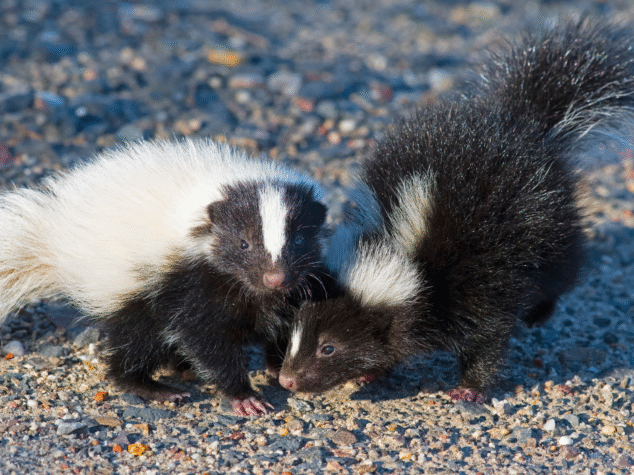Skunks are nocturnal creatures that often prefer quiet, dark places to call home. While they are typically found in wooded areas or underbrush, urban and suburban environments provide an ideal setting for them to thrive. If you’ve noticed skunk activity near the foundation of your home or business, it's crucial to act quickly—not just for your safety but also for theirs. Skunks may look cute, but they can be problematic when they make their way onto your property.
Understanding what attracts skunks to your home and how to safely relocate them can help protect your property and prevent unwanted encounters.
What Attracts Skunks to Your Foundation?
1. Shelter and Safety
Skunks often seek out areas close to the foundation of buildings because they provide ideal shelter. Foundations offer dark, secure spaces that are out of sight from predators and where skunks can build dens or nest. Gaps in the foundation or vents are common entry points.
2. Easy Access to Food
Skunks are opportunistic feeders, meaning they will eat almost anything they can find. If your property has a food source, like garbage, pet food, or fallen fruit from trees, you may attract skunks. Skunks are particularly fond of insects, rodents, and small plants, making your lawn, garden, or compost pile an inviting place for them.
3. Water Sources
Skunks are attracted to areas with easy access to water, especially during the warmer months. Standing water in bird baths, puddles, and leaking pipes near the foundation can serve as a water source for skunks, encouraging them to linger.
4. Easy Entry Points
Skunks are adept at squeezing through small spaces. Gaps in the foundation, broken vent covers, or holes in the siding are all potential access points. If there’s an opening wide enough to accommodate their small size, skunks will take advantage of it to seek shelter or establish a den.
Signs of Skunk Activity
- Strong Odor: The most obvious sign of a skunk's presence is the distinct, pungent smell they leave behind, especially if they feel threatened.
- Tracks: Look for small, paw-like tracks near the foundation or yard. Skunk footprints often show up in soft dirt or mud.
- Visible Holes: Skunks dig small, shallow holes in lawns while hunting for insects or worms, which may be evident near the foundation.
- Nocturnal Activity: If you notice activity at night, such as rustling sounds or the sound of scurrying near your foundation, it could be a skunk looking for food or shelter.
How to Safely Relocate Skunks
Relocating skunks is a delicate process because they can become aggressive when threatened, and their spray is a powerful defense mechanism. Here’s how to handle it:
1. Avoid DIY Trapping Without Expertise
Skunks are not the type of pest you want to handle without the proper tools and knowledge. Their spray can cause serious irritation and lingering odors. If you need to trap a skunk, it’s best to call a wildlife control professional who has experience in handling them safely.
2. Use Humane Traps
Humane traps allow you to capture a skunk without harming it. These traps typically feature a sliding door that closes once the animal enters. If you're attempting this yourself, place the trap near the foundation or in an area where you've noticed skunk activity. Bait the trap with a food source like peanut butter, canned tuna, or cat food.
3. Relocate the Skunk Safely
Once trapped, relocate the skunk to an area far enough away from your home or business to discourage it from returning. Make sure to check local regulations, as some areas have laws about releasing wild animals.
4. Use a Skunk-Specific Trap Cover
Skunks can be easily stressed by visual stimuli. Consider covering the trap with a cloth to calm the animal while you move it. Be sure to avoid startling or handling the skunk while it’s in the trap.
5. Wear Protective Gear
If you must handle the trap, wear gloves and a long-sleeved shirt to avoid any potential contact. Skunks can feel threatened if you get too close.
Preventing Future Skunk Visits
1. Seal Entry Points
Inspect your foundation, vents, and walls for gaps or cracks that could provide entry points. Use durable materials like steel mesh, foam, or concrete to seal these openings. Don’t forget to check the area around pipes, wires, and vents.
2. Remove Food Sources
Skunks are attracted to easy food sources, so make sure to secure garbage cans with tight-fitting lids, store pet food indoors, and clean up fallen fruits or nuts from trees. If you have a compost pile, ensure it's well-covered or enclosed.
3. Remove Water Sources
Fix leaky pipes, clear out clogged gutters, and remove standing water from your property to make it less appealing to skunks. Pay attention to areas where water tends to collect after rain.
4. Use Natural Deterrents
Natural deterrents like predator urine (fox or coyote) or essential oils such as peppermint and citronella can help discourage skunks from taking up residence on your property. Place these near areas where skunks are likely to enter or nest.
While skunks can be beneficial to the environment by controlling insect and rodent populations, it’s important to take steps to prevent them from making your home or business their home. By understanding what attracts them, taking steps to relocate them safely, and implementing preventive measures, you can keep your property safe from these nocturnal critters.
Remember, if you’re not comfortable handling a skunk situation on your own, it’s always best to consult with a professional wildlife removal service.

